An Anti-Interference Online Monitoring Method for IGBT Bond Wire Aging
Abstract
1. Introduction
- Current-based parameter: short-circuit current (Is). In [15], the authors took the Is as the monitoring parameter for bond wire aging. When the number of broken bond wires in the IGBT module gradually increases, the Is will decrease accordingly. However, this method needs to inject current into the IGBT module, which is not suitable for online monitoring application scenarios.
- Time-based parameter: turn-on time (ton) and turn-off time (toff). The authors in [16,17] calculated ton by measuring the current and voltage waveforms during IGBT turn-on and monitor bond wire failures accordingly. The experimental results show that the ton under the bond wire failure was shorter than that under the healthy state. In [18], the charging time of the gate capacitance was measured by injecting a small current during the IGBT turn-off period to monitor the health status of the bond wires. Since the switching time of the IGBT was in the range of 10–500 ns, the time-based parameters had extremely high requirements for the hardware measurement circuit.
- Voltage-based parameter: gate voltage (Vg) and collector-emitter on-state voltage (Vce_on). In [19], the Vge was used to monitor the multi-chip parallel IGBT modules’ health status. The experimental results showed that this method would not be affected by load current changes or noise caused by switching. However, only when all bond wires of a specific IGBT chip were broken did the Vge change significantly. The application of this method was limited to multi-chip parallel IGBT modules, which are not universal. The authors of [20,21] cut the bond wire to simulate IGBT aging and monitor the IGBT health status by measuring Vce_on online. The results indicated that Vce_on could accurately identify the number of broken bond wires.
- Temperature-based parameter: junction temperature (Tj) and thermal resistance (Rth). In [22], the case temperature (Tc) and junction temperature (Tj) were observed by thermocouples to calculate the Rth. When the Rth increased by 20%, the IGBT module failed. However, this method needs to invade the IGBT module package for measurement, which is not conducive to online monitoring. In [23], Tj was obtained by measuring the linear relationship between Vce_on and Tj, whereas in [24], Tj was calculated by the turn-off overshoot voltage. It is worth noting that Tj cannot directly reflect the aging state of the IGBT, but it has a close coupling relationship with other parameters, which are called thermosensitive electrical parameters (TSEPs) [25,26]. Almost all the above monitoring parameters for bond wire are TSEPs.
2. IGBT Bond Wire Aging Modeling
2.1. Bond Wire Aging Mechanism
2.2. Bond Wire Aging Model
3. Online Monitoring of IGBT Bond Wire Aging
3.1. Sampling Circuit
3.2. Online Monitoring
4. Experiment and Result Analysis
4.1. Sampling under DC Voltage Fluctuations
4.2. Junction Temperature Interference
4.3. Aging Monitoring Results
5. Conclusions
Author Contributions
Funding
Conflicts of Interest
References
- Choi, U.-M.; Blaabjerg, F.; Lee, K.-B. Study and Handling Methods of Power IGBT Module Failures in Power Electronic Converter Systems. IEEE Trans. Power Electron. 2015, 30, 2517–2533. [Google Scholar] [CrossRef]
- Li, H.; Liao, X.; Zeng, Z.; Hu, Y.; Li, Y.; Liu, S.; Ran, L. Thermal Coupling Analysis in a Multichip Paralleled IGBT Module for a DFIG Wind Turbine Power Converter. IEEE Trans. Energy Convers. 2016, 32, 80–90. [Google Scholar] [CrossRef]
- Lai, W.; Wang, Z.; Hu, Y.; Chen, M.; Xia, H.; Luo, D.; Wei, Y.; Gao, B.; Chen, Y. Evaluation of IGBT Module Remaining Lifetime in Wind Power Converters Considering Impacts of Failure Location. IEEE Trans. Electron Devices 2021, 68, 1810–1818. [Google Scholar] [CrossRef]
- Reigosa, P.D.; Wang, H.; Yang, Y.; Blaabjerg, F. Prediction of Bond Wire Fatigue of IGBTs in a PV Inverter under a Long-Term Operation. IEEE Trans. Power Electron. 2015, 31, 7171–7182. [Google Scholar] [CrossRef]
- Ji, B.; Song, X.; Cao, W.; Pickert, V.; Hu, Y.; Mackersie, J.W.; Pierce, G. In Situ Diagnostics and Prognostics of Solder Fatigue in IGBT Modules for Electric Vehicle Drives. IEEE Trans. Power Electron. 2015, 30, 1535–1543. [Google Scholar] [CrossRef]
- Buticchi, G.; Barater, D.; Costa, L.F.; Liserre, M. A PV-Inspired Low-Common-Mode Dual-Active-Bridge Converter for Aerospace Applications. IEEE Trans. Power Electron. 2018, 33, 10467–10477. [Google Scholar] [CrossRef]
- Yang, S.; Xiang, D.; Bryant, A.; Mawby, P.; Ran, L.; Tavner, P. Condition Monitoring for Device Reliability in Power Electronic Converters: A Review. IEEE Trans. Power Electron. 2010, 25, 2734–2752. [Google Scholar] [CrossRef]
- Oh, H.; Han, B.; McCluskey, P.; Han, C.; Youn, B.D. Physics-of-Failure, Condition Monitoring, and Prognostics of Insulated Gate Bipolar Transistor Modules: A Review. IEEE Trans. Power Electron. 2015, 30, 2413–2426. [Google Scholar] [CrossRef]
- Abuelnaga, A.; Narimani, M.; Bahman, A.S. A Review on IGBT Module Failure Modes and Lifetime Testing. IEEE Access. 2021, 9, 9643–9663. [Google Scholar] [CrossRef]
- Hu, K.; Liu, Z.; Yang, Y.; Iannuzzo, F.; Blaabjerg, F. Ensuring a Reliable Operation of Two-Level IGBT-Based Power Converters: A Review of Monitoring and Fault-Tolerant Approaches. IEEE Access. 2020, 8, 89988–90022. [Google Scholar] [CrossRef]
- Wang, H.; Liserre, M.; Blaabjerg, F.; Rimmen, P.D.P.; Jacobsen, J.B.; Kvisgaard, T.; Landkildehus, J. Transitioning to Physics-of-Failure as a Reliability Driver in Power Electronics. IEEE J. Emerg. Sel. Top. Power Electron. 2014, 2, 97–114. [Google Scholar] [CrossRef]
- Sabbah, W.; Arabi, F.; Avino-Salvado, O.; Buttay, C.; Théolier, L.; Morel, H. Lifetime of power electronics interconnections in accelerated test conditions: High temperature storage and thermal cycling. Microelectron. Reliab. 2017, 76–77, 444–449. [Google Scholar] [CrossRef]
- Hanif, A.; Devoto, D.; Khan, F.H. Bond Wire Damage Detection and SOH Estimation of a Dual-Pack IGBT Power Module Using Active Power Cycling and Reflectometry. IEEE Trans. Power Electron. 2019, 35, 6761–6772. [Google Scholar] [CrossRef]
- Gonzalez-Hernando, F.; San-Sebastian, J.; Garcia-Bediaga, A.; Arias, M.; Iannuzzo, F.; Blaabjerg, F. Wear-Out Condition Monitoring of IGBT and mosfet Power Modules in Inverter Operation. IEEE Trans. Ind. Appl. 2019, 55, 6184–6192. [Google Scholar] [CrossRef]
- Sun, P.; Gong, C.; Du, X.; Peng, Y.; Wang, B.; Zhou, L. Condition Monitoring IGBT Module Bond Wires Fatigue Using Short-Circuit Current Identification. IEEE Trans. Power Electron. 2016, 32, 3777–3786. [Google Scholar] [CrossRef]
- Zhou, L.; Zhou, S.; Xu, M. Investigation of gate voltage oscillations in an IGBT module after partial bond wires lift-off. Microelectron. Reliab. 2013, 53, 282–287. [Google Scholar] [CrossRef]
- Zhou, S.; Zhou, L.; Sun, P. Monitoring Potential Defects in an IGBT Module Based on Dynamic Changes of the Gate Current. IEEE Trans. Power Electron. 2013, 28, 1479–1487. [Google Scholar] [CrossRef]
- Wang, K.; Zhou, L.; Sun, P.; Du, X. Monitoring Bond Wires Fatigue of Multichip IGBT module Using Time Duration of The Gate Charge. IEEE Trans. Power Electron. 2020, 36, 888–897. [Google Scholar] [CrossRef]
- Mandeya, R.; Chen, C.; Pickert, V.; Naayagi, R.T.; Ji, B. Gate–Emitter Pre-threshold Voltage as a Health-Sensitive Parameter for IGBT Chip Failure Monitoring in High-Voltage Multichip IGBT Power Modules. IEEE Trans. Power Electron. 2018, 34, 9158–9169. [Google Scholar] [CrossRef]
- Choi, U.-M.; Blaabjerg, F.; Jorgensen, S.; Munk-Nielsen, S.; Rannestad, B. Reliability Improvement of Power Converters by Means of Condition Monitoring of IGBT Modules. IEEE Trans. Power Electron. 2017, 32, 7990–7997. [Google Scholar] [CrossRef]
- Choi, U.-M.; Blaabjerg, F. Separation of Wear-Out Failure Modes of IGBT Modules in Grid-Connected Inverter Systems. IEEE Trans. Power Electron. 2017, 33, 6217–6223. [Google Scholar] [CrossRef]
- Sathik, M.H.M.; Sundararajan, P.; Sasongko, F.; Pou, J.; Natarajan, S. Comparative Analysis of IGBT Parameters Variation Under Different Accelerated Aging Tests. IEEE Trans. Electron Devices 2020, 67, 1098–1105. [Google Scholar] [CrossRef]
- Wang, X.; Sun, P.; Sun, L.; Luo, Q.; Du, X. Online Condition Monitoring for Bond Wire Degradation of IGBT Modules in Three-Level Neutral-Point-Clamped Converters. IEEE Trans. Ind. Electron. 2021, 68, 7474–7484. [Google Scholar] [CrossRef]
- Yang, Y.; Zhang, P. In situ IGBT Junction Temperature Estimation Method via a Bond Wire Degradation Independent Parameter Turn-off Vce Overshoot. IEEE Trans. Ind. Electron. 2020, PP, 1. [Google Scholar] [CrossRef]
- Zhang, J.; Du, M.; Jing, L.; Wei, K.; Hurley, W.G. IGBT Junction Temperature Measurements: Inclusive of Dynamic Thermal Parameters. IEEE Trans. Device Mater. Reliab. 2019, 19, 333–340. [Google Scholar] [CrossRef]
- Avenas, Y.; Dupont, L.; Khatir, Z. Temperature Measurement of Power Semiconductor Devices by Thermo-Sensitive Electrical Parameters—A Review. IEEE Trans. Power Electron. 2012, 27, 3081–3092. [Google Scholar] [CrossRef]
- Fang, X.; Lin, S.; Huang, X.; Lin, F.; Yang, Z.; Igarashi, S. A review of data-driven prognostic for IGBT remaining useful life. Chin. J. Electr. Eng. 2018, 4, 73–79. [Google Scholar] [CrossRef]
- Ma, M.; Ji, B.; Han, J.; Zhan, M.; Xiang, N. In-situ health monitoring of IGBT modules of an on-line medium-voltage inverter system using for industrial Internet of Things. CSEE J. Power Energy Syst. 2020, 6, 638–648. [Google Scholar] [CrossRef]
- Yang, Y.; Zhang, Q.; Zhang, P. A Fast IGBT Junction Temperature Estimation Approach Based on ON-State Voltage Drop. IEEE Trans. Ind. Appl. 2021, 57, 685–693. [Google Scholar] [CrossRef]
- Ji, B.; Pickert, V.; Cao, W.; Zahawi, B. In Situ Diagnostics and Prognostics of Wire Bonding Faults in IGBT Modules for Electric Vehicle Drives. IEEE Trans. Power Electron. 2013, 28, 5568–5577. [Google Scholar] [CrossRef]
- He, Y. IGBT Module Reliability Evaluation Method and Device Based on Bonding Lead Degradation. C.N. Patent 111,856,233B, 27 April 2021. [Google Scholar]
- Ciappa, M. Selected failure mechanisms of modern power modules. Microelectron. Reliab. 2002, 42, 653–667. [Google Scholar] [CrossRef]
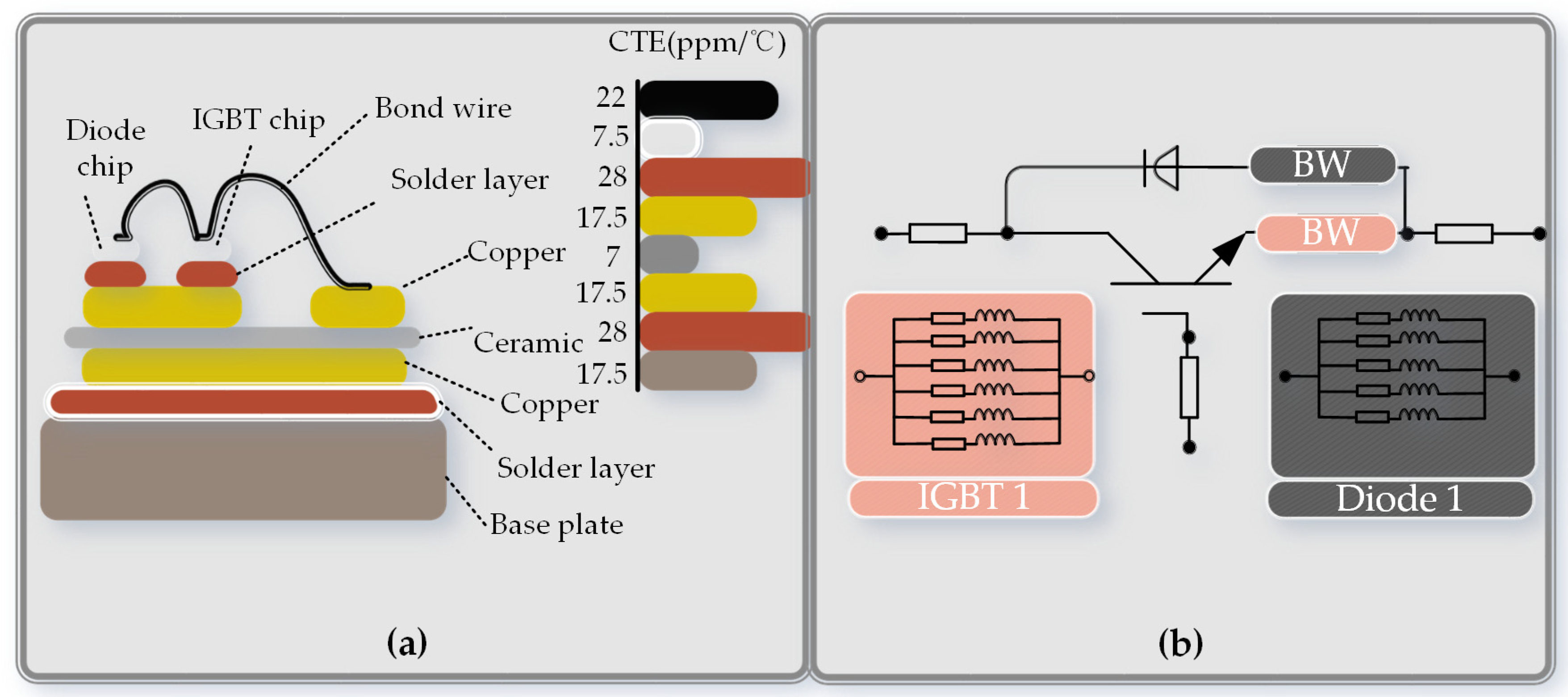
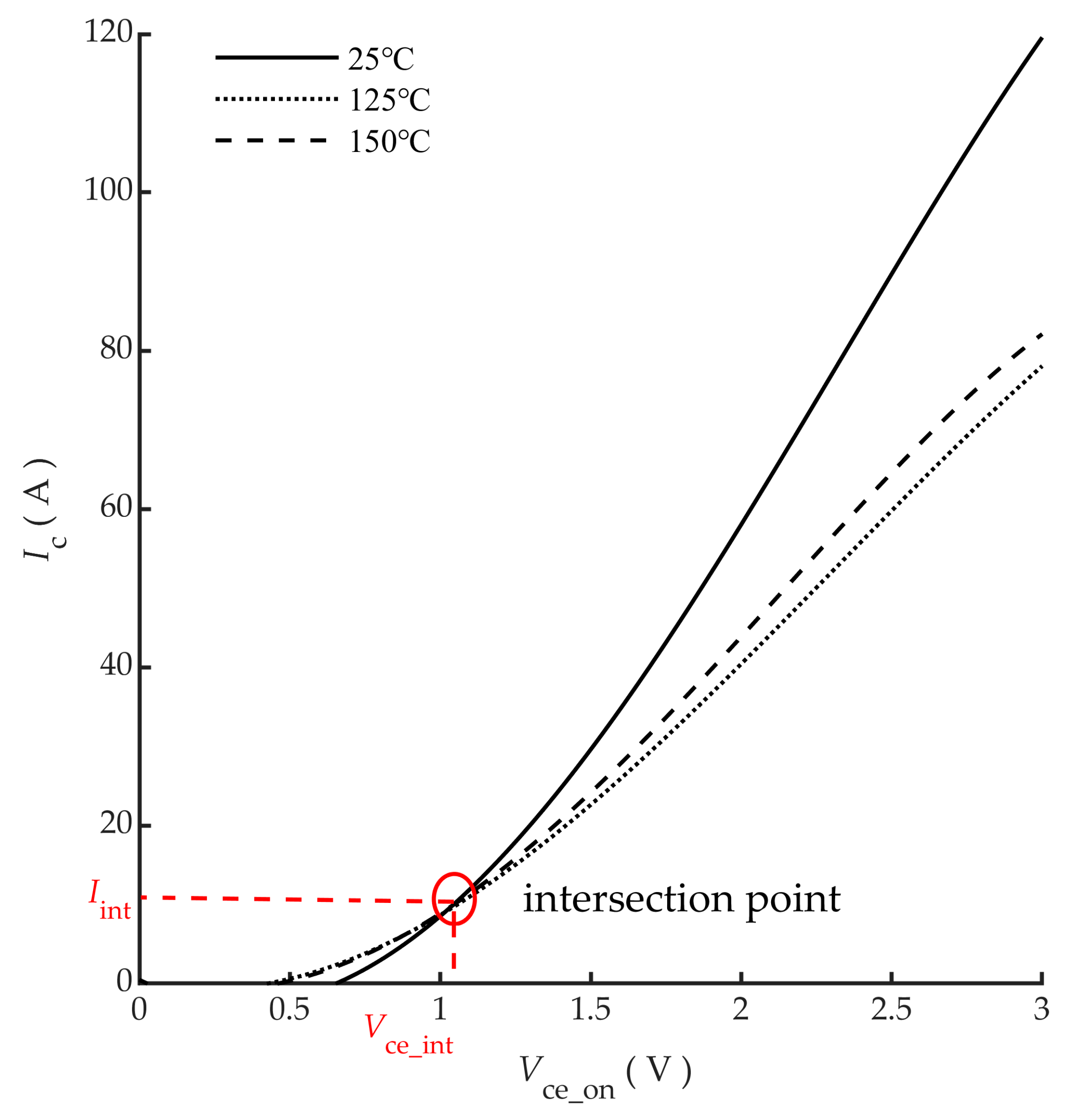

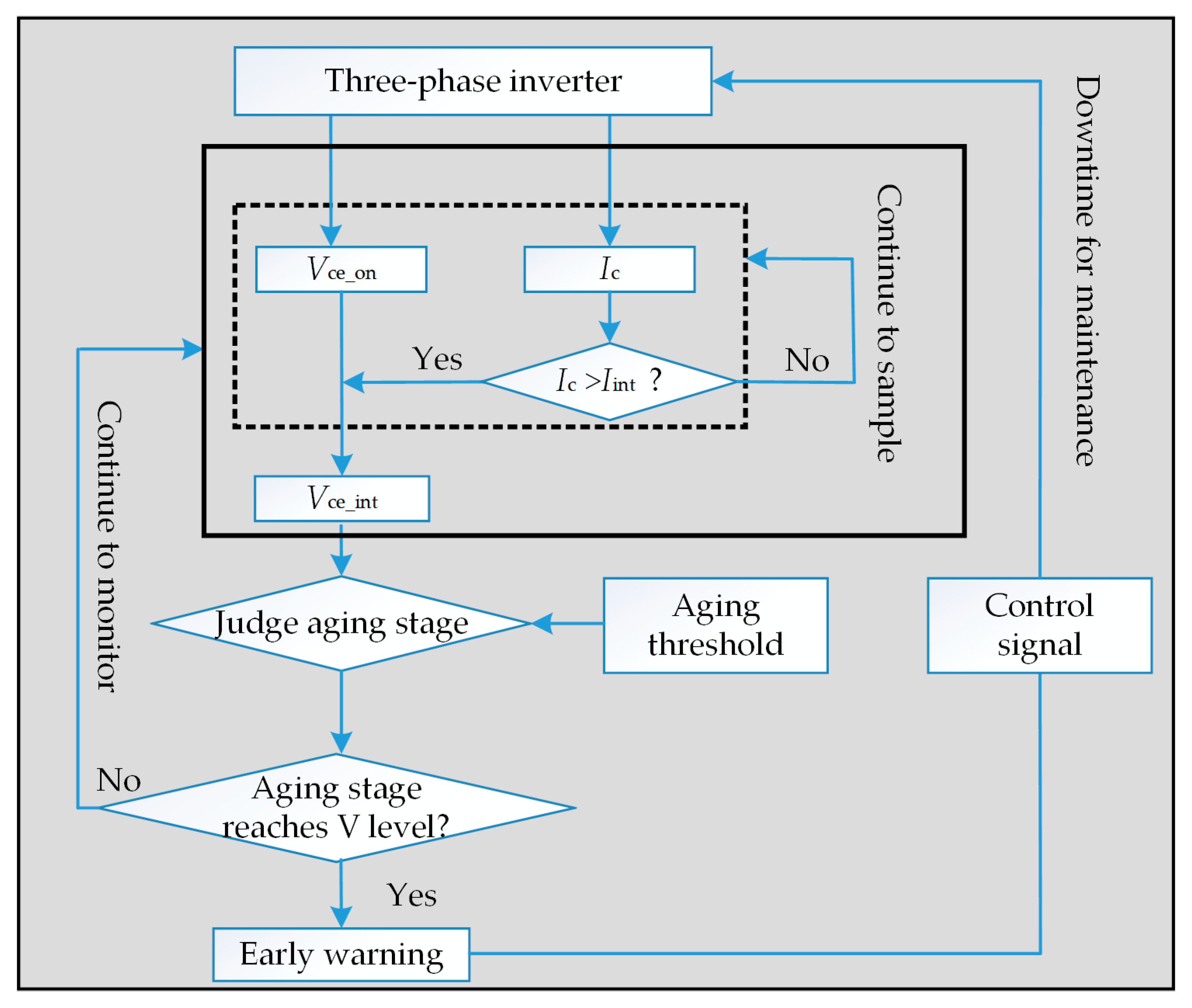
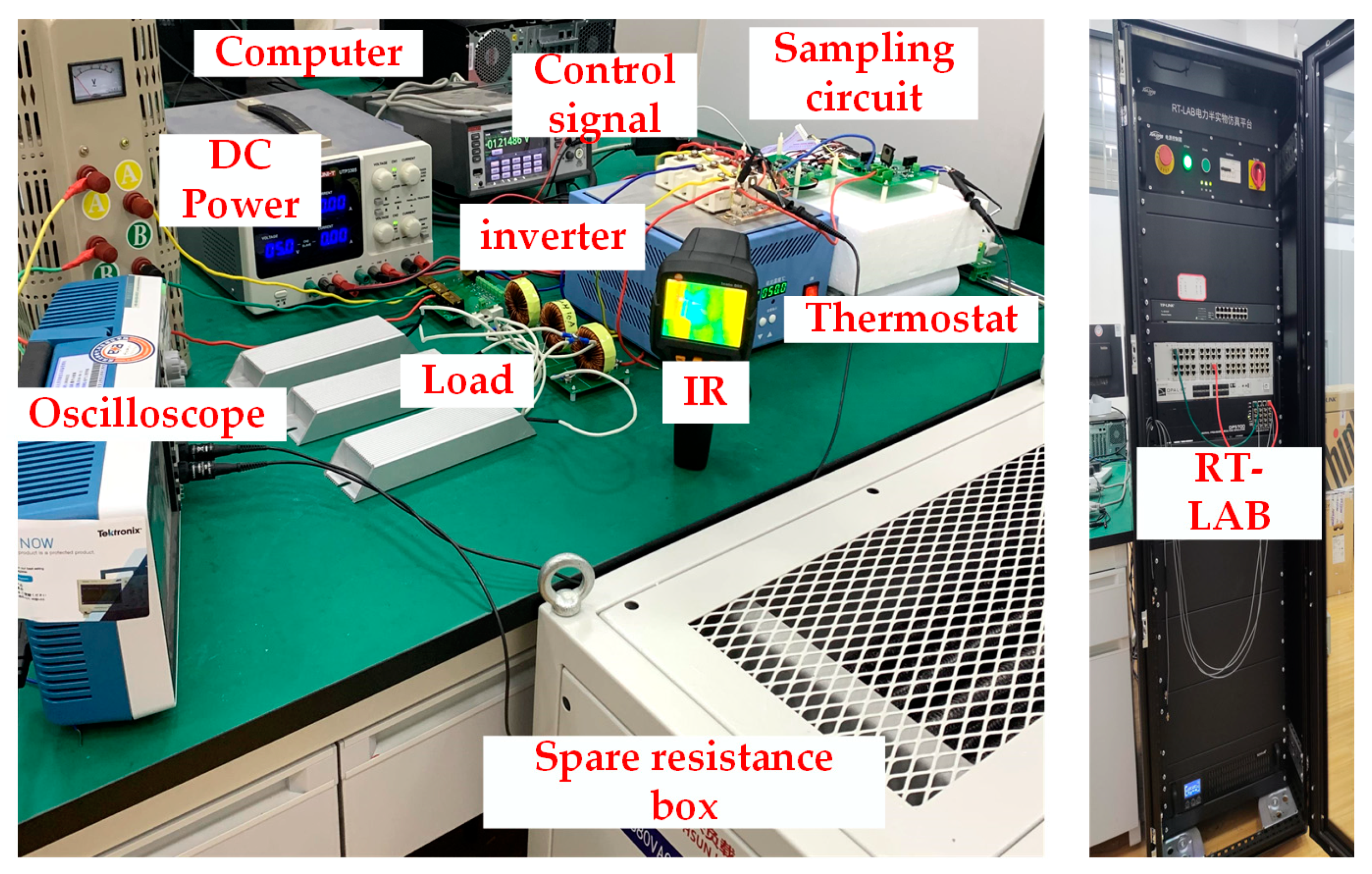
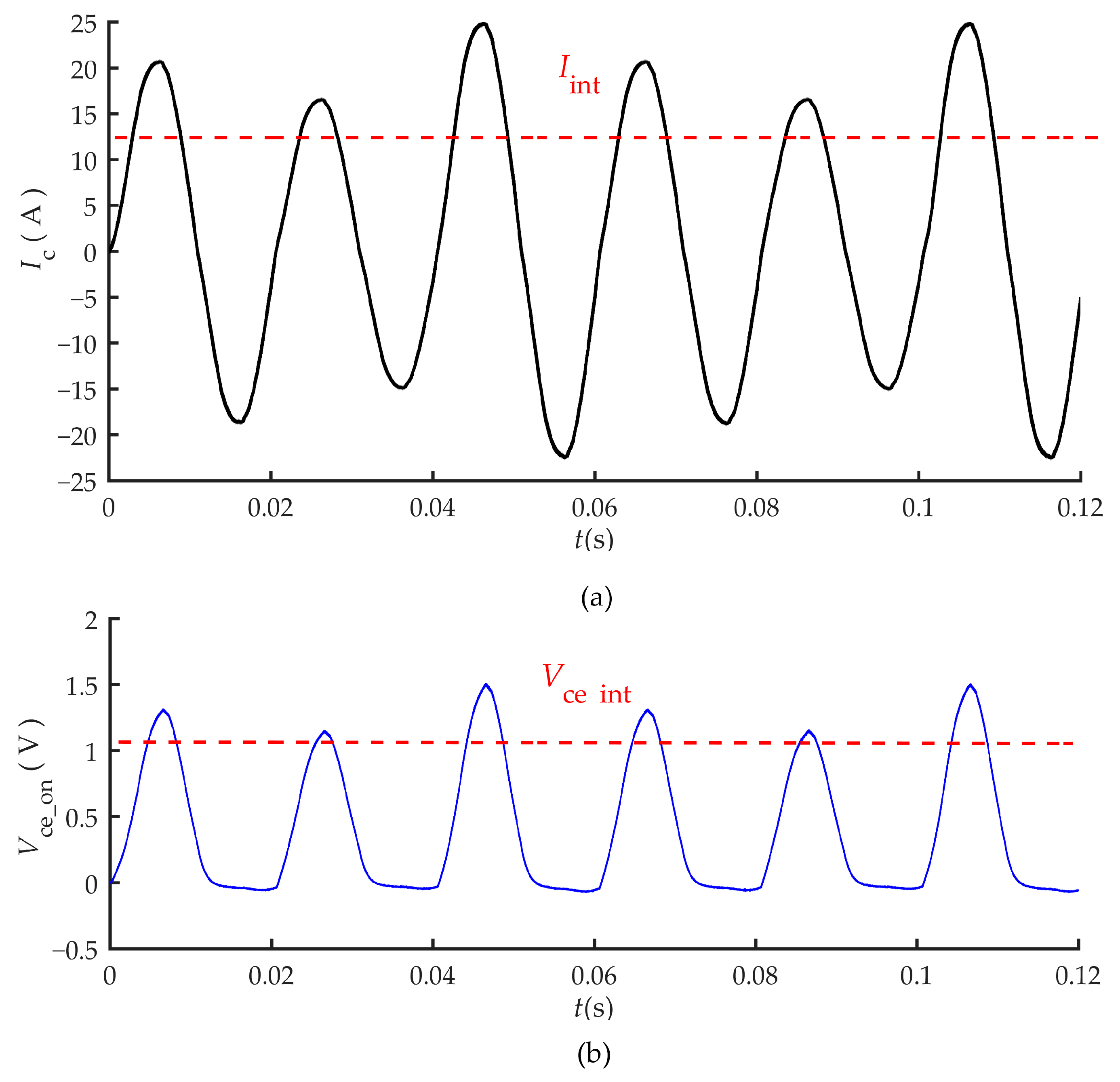
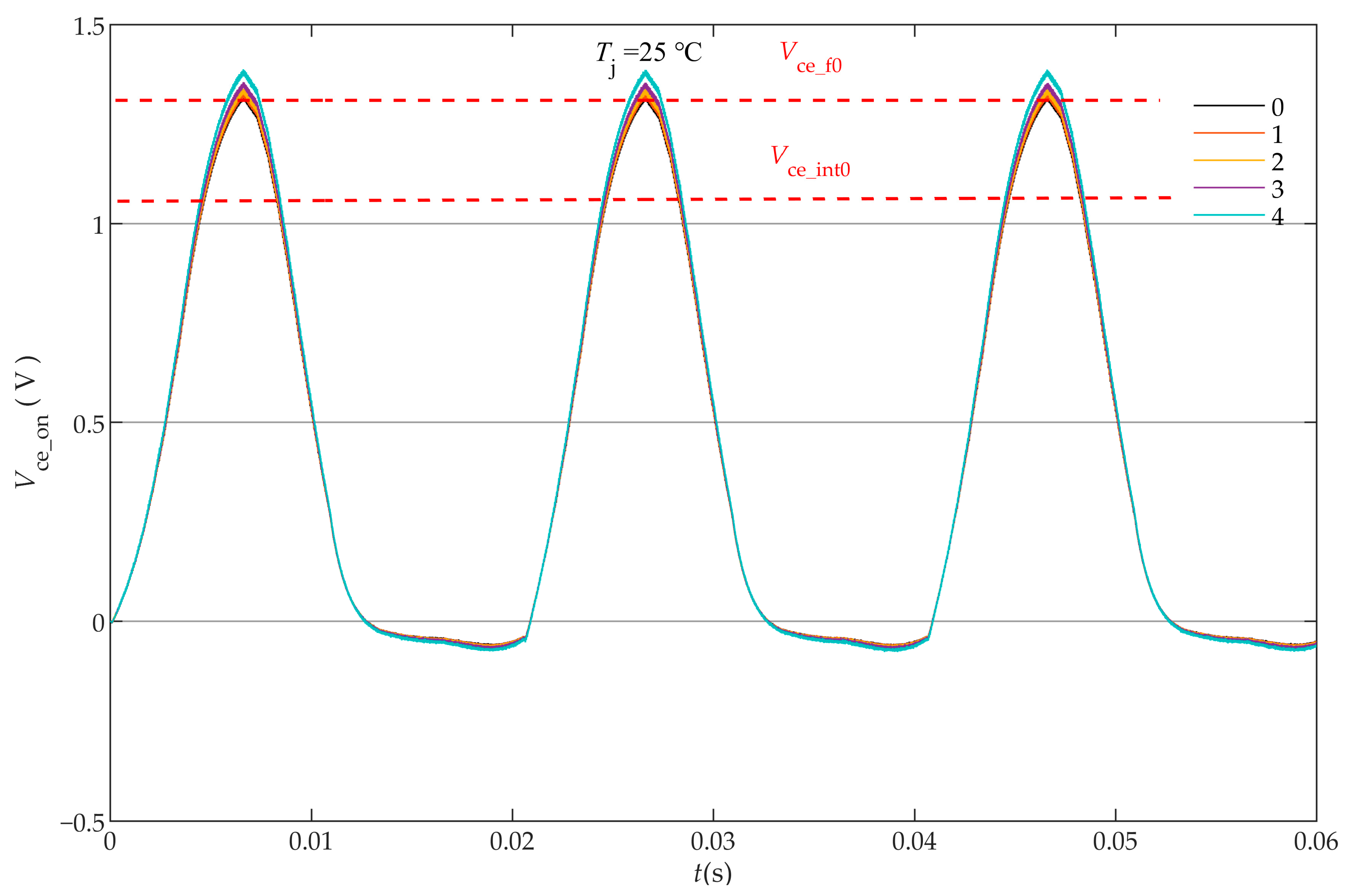

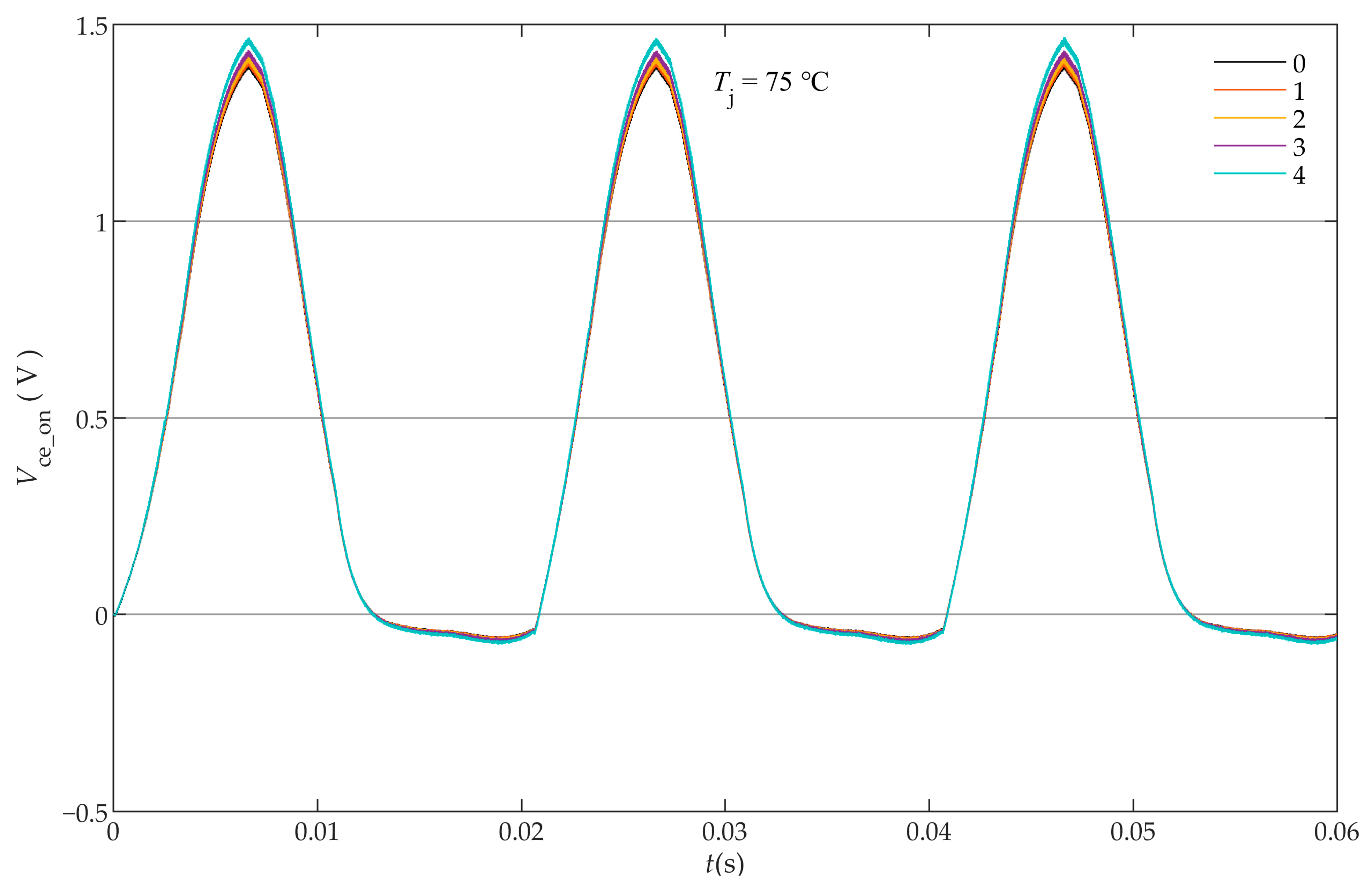
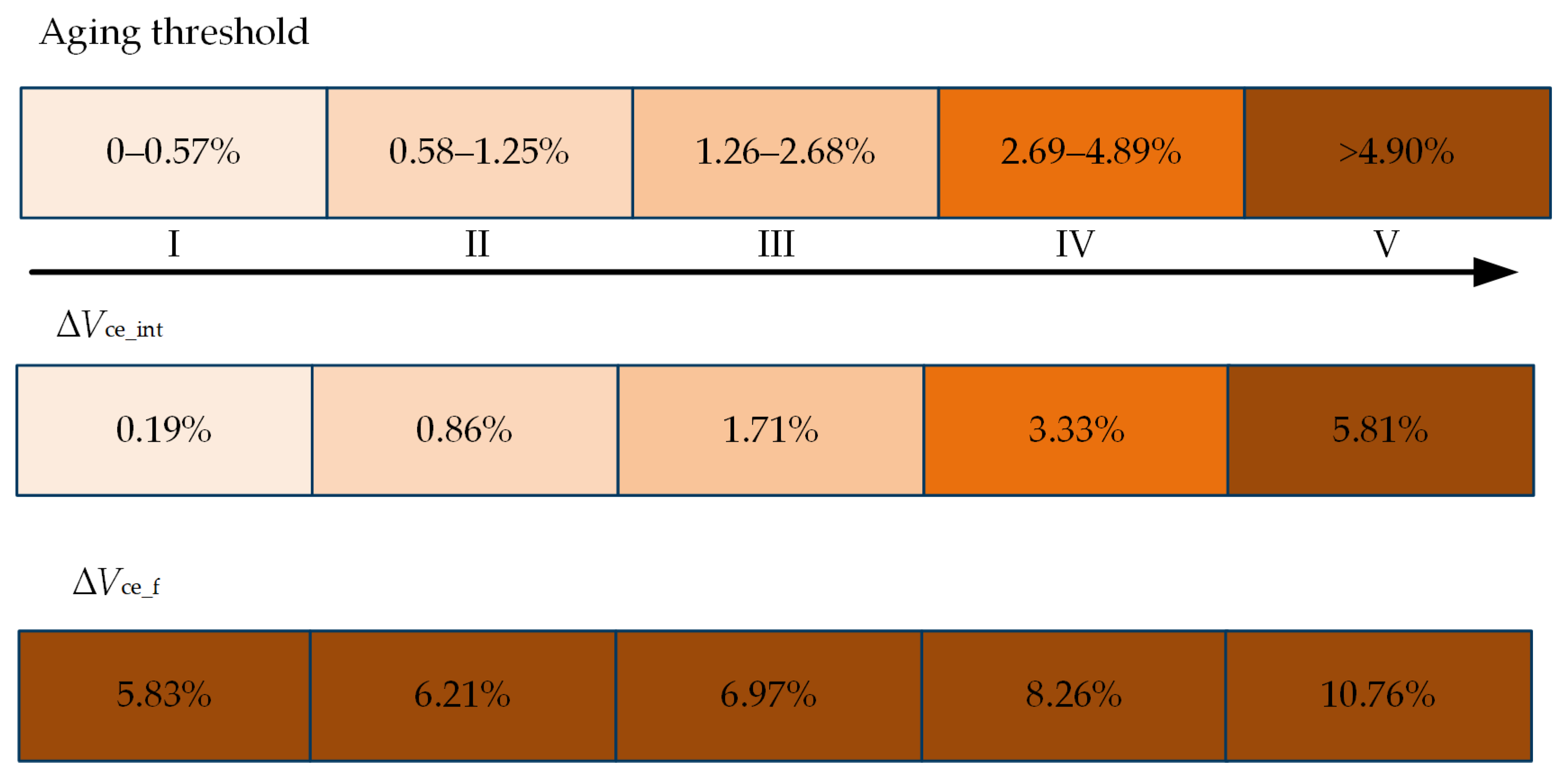
| Switch | M1 | M2 | M3 | M4 |
|---|---|---|---|---|
| S1 on | 1 | 0 | 0 | 0 |
| S1 off | 0 | 1 | 0 | 0 |
| S2 on | 0 | 0 | 1 | 0 |
| S2 off | 0 | 0 | 0 | 1 |
| Parameters | Values |
|---|---|
| Switching frequency (fsw) | 20 kHz |
| Output frequency (f) | 50 Hz |
| IGBT module type | FF50R12RT4 |
| IR type | Testo 865 |
| Thermostat type | JF-966 |
| Junction temperature (Tj) | 25–75 °C |
| Number of broken bond wires | 0–4 |
| Resolution of ADC | 16-bit |
| Gain band width of amplifier | 4 MHz |
| Number of Broken Bond Wires | Aging Threshold for Vce_int | Aging Threshold for Vce_f | Aging States |
|---|---|---|---|
| 0 | <0.57% | <0.68% | I |
| 1 | 0.58–1.25% | 0.69–1.14% | II |
| 2 | 1.26–2.68% | 1.15–2.58% | III |
| 3 | 2.69–4.89% | 2.59–4.86% | VI |
| 4 | >4.90% | >4.86% | V |
| Number of Broken Bond Wires | Vce_int (V) | ΔVce_int | Vce_f (V) | ΔVce_f |
|---|---|---|---|---|
| 0 | 1.052 | 0.19%, I | 1.397 | 5.83%, V |
| 1 | 1.059 | 0.86%, II | 1.402 | 6.21%, V |
| 2 | 1.068 | 1.71%, III | 1.412 | 6.97%, V |
| 3 | 1.085 | 3.33%, IV | 1.429 | 8.26%, V |
| 4 | 1.111 | 5.81%, V | 1.462 | 10.76%, V |
Publisher’s Note: MDPI stays neutral with regard to jurisdictional claims in published maps and institutional affiliations. |
© 2021 by the authors. Licensee MDPI, Basel, Switzerland. This article is an open access article distributed under the terms and conditions of the Creative Commons Attribution (CC BY) license (https://creativecommons.org/licenses/by/4.0/).
Share and Cite
Wang, C.; He, Y.; Jiang, Y.; Li, L. An Anti-Interference Online Monitoring Method for IGBT Bond Wire Aging. Electronics 2021, 10, 1449. https://doi.org/10.3390/electronics10121449
Wang C, He Y, Jiang Y, Li L. An Anti-Interference Online Monitoring Method for IGBT Bond Wire Aging. Electronics. 2021; 10(12):1449. https://doi.org/10.3390/electronics10121449
Chicago/Turabian StyleWang, Chuankun, Yigang He, Yunfeng Jiang, and Lie Li. 2021. "An Anti-Interference Online Monitoring Method for IGBT Bond Wire Aging" Electronics 10, no. 12: 1449. https://doi.org/10.3390/electronics10121449
APA StyleWang, C., He, Y., Jiang, Y., & Li, L. (2021). An Anti-Interference Online Monitoring Method for IGBT Bond Wire Aging. Electronics, 10(12), 1449. https://doi.org/10.3390/electronics10121449





